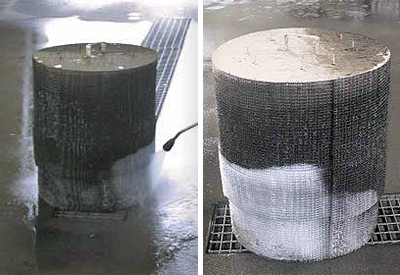Advantages of HD Q-PAC®
HD Q-PAC vs. conventional coalescing media
HD Q-PAC® can be seen to be a radical departure from the traditional, inclined or corrugated plate design of past oil water separation coalescing media (see Media Design).
High Flow Rates
The traditional oil water separation media, such as mesh pads and inclined plates, is forced to leave holes in the media to allow for rising oil droplets. The optimized design of the HD Q-PAC®, however, allows oil to coat the entire surface of the coaleascing media. This allows for steady, unimpeded rise of oil droplets upward and sludge downward throughout its entire structure.
When using HD Q-PAC® coalescing media to design new oil water separators, much smaller OWS units become very efficient and practical in comparison to historic design standards. Significant savings will be the result!
High Surface Area
With all rounded elements, the entire surface area of 132 ft2/ft3 (433 m2/m3) of HD Q-PAC® is available to support oil droplet coalescence. Our coalescing media removes over 99.9% of oil droplets 20 microns and larger, which meets both EPA Method 1664 Revision A and European Standard EN 858-1.
As a result, there is no need for any type of second stage polishing to achieve needed oil removal. This fact is based upon HD Q-PAC® fulfilling the European Union's EN 858-1, Test Method for Class I Coalescing Separator (see Performance Standard).
HD Q-PAC® has the highest effective coalescing surface than any other media on the marketplace, allowing a much higher efficiency.
| Media Type | Specific Surface Area |
|---|---|
| Corrugated Sheet Media PVC or PP, ¾” (19-mm) spacing |
42 ft2/ft3 (138 m2/m3) |
| Corrugated Sheet Media PVC or PP, ½” (12-mm) spacing |
68 ft2/ft3 (223 m2/m3) |
| HD Q-PAC® | 132 ft2/ft3 (433 m2/m3) |
Anti-Plugging
Conventional corrugated-sheet media have thousands of narrow spaces. Wherever adjacent sheets touch each other they form a pair of crevices where even small suspended solids can become trapped. Solids begin to accumulate in these narrow spots, and gradually build up until the openings in the media are fully bridged — forcing water to flow faster through the remaining unclogged openings. This impairs both flow capacity and oil separation efficiency.
HD Q-PAC® has no tight spots for solids to lodge in. All of its polypropylene elements intersect at 90° angles, and there are no openings less than 4 mm across. With 75,000 drip points (a forest of rods) per ft3 (2.65 x 106 per m3), the media has a 87% void volume. This provides excellent anti-plugging properties in oil water separators with heavy sludge, dirt and biological growth loadings, as those heavy objects will fall readily into the sludge compartment.
Easy Cleaning
When conventional media, such as a mesh pad or corrugated media, is used in an oil water separator unit, the media can plug frequently. Once fouled, the media needs to be cleaned and often replaced, causing significant loss of time and high maintenance costs.
Due to its anti-plugging properties, the HD Q-PAC does not need to be cleaned as often as traditional media. Also, its design allows for self-cleaning or easy cleaning with a simple water spray (such as an ordinary high pressure water hose) when needed.

The cleaning of the HD Q-PAC® is shown (left) as well the
result (right).
High Temperatures
One advantage of using polypropylene is that the oil water separator can operate with water temperatures up to 212°F (100°C). The cheaper corrugated medias from our competitors are made from PVC and begin to weaken at 120°F (49°C).
